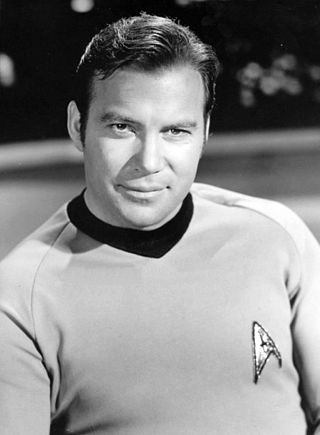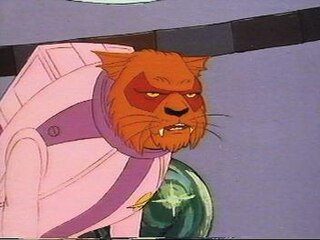Related Research Articles

Star Trek: The Animated Series (TAS) is an American animated science fiction television series created by Gene Roddenberry. It originally aired simply under the title Star Trek, subtitled Created by Gene Roddenberry, on Saturday mornings from September 8, 1973 to October 12, 1974 on NBC, spanning 22 episodes over two seasons. The second series in the Star Trek franchise, it features mostly the same characters as Star Trek: The Original Series. Set in the 23rd century, the series follows the further adventures of the Starship USS Enterprise as it explores the galaxy.

The Romulans are an extraterrestrial race in the American science fiction franchise Star Trek. Their adopted home world is Romulus, and within the same star system they have settled a sister planet Remus. Their original home world, Vulcan, was renamed Ni'Var later in canon. They first appeared in the series Star Trek (1966–1969). They have appeared in most subsequent Star Trek releases, including The Animated Series, The Next Generation, Deep Space Nine, Voyager, Enterprise, Discovery, Picard, Strange New Worlds, and Lower Decks. They appear in the Star Trek feature films Star Trek V: The Final Frontier (1989), Star Trek VI: The Undiscovered Country (1991), Star Trek: Nemesis (2002) and Star Trek (2009). They also appear in various other spin-off media, including books, comics, toys and games.

James Tiberius Kirk, commonly known as James T. Kirk or Captain Kirk, is a fictional character in the Star Trek media franchise. Originally played by Canadian actor William Shatner, Kirk first appeared in Star Trek serving aboard the starship USS Enterprise as captain. Kirk leads his crew as they explore new worlds, new civilizations, and "boldly go where no man has gone before". Often, the characters of Spock and Leonard "Bones" McCoy act as his logical and emotional sounding boards, respectively. Kirk has also been portrayed in numerous films, books, comics, webisodes, and video games.

Vulcans, sometimes referred to as Vulcanians, are a fictional extraterrestrial humanoid species in the Star Trek universe and media franchise. In the various Star Trek television series and films, they are noted for their attempt to live by logic and reason with as little interference from emotion as possible. Known for their pronounced eyebrows and pointed ears, they originate from the fictional planet Vulcan. In the Star Trek universe, they were the first extraterrestrial species to make contact with humans.

Spock is a fictional character in the Star Trek media franchise. He first appeared in the original Star Trek series serving aboard the starship USS Enterprise as science officer and first officer and later as commanding officer of the vessel. Spock's mixed human–Vulcan heritage serves as an important plot element in many of the character's appearances. Along with Captain James T. Kirk and Dr. Leonard "Bones" McCoy, he is one of the three central characters in the original Star Trek series and its films. After retiring from active duty in Starfleet, Spock served as a Federation ambassador, and later became involved in the ill-fated attempt to save Romulus from a supernova, leading him to live out the rest of his life in a parallel universe.

Nyota Uhura, or simply Uhura, is a fictional character in the Star Trek franchise. In the original television series, the character was portrayed by Nichelle Nichols, who reprised the role for the first six Star Trek feature films. A younger Uhura is portrayed by Celia Rose Gooding in the 2022 prequel series Star Trek: Strange New Worlds, while an alternate timeline version of Uhura has been portrayed by actress Zoe Saldaña in the feature films Star Trek (2009), Star Trek Into Darkness (2013), and Star Trek Beyond (2016).

The Gorn are a fictional extraterrestrial humanoid reptilian species in the American science fiction franchise Star Trek. They first appeared in a 1967 episode of the original series, "Arena", in which Captain Kirk fights an unnamed Gorn on a rocky planet. The fight scene has become one of the best-remembered scenes of the original series, in part due to the slow and lumbering movement of the Gorn, which some viewers have considered unintentionally comical.
"Balance of Terror" is the fourteenth episode of the first season of the American science fiction television series Star Trek. Written by Paul Schneider and directed by Vincent McEveety, it first aired on December 15, 1966.

"The Neutral Zone" is the season finale of the first season of the American science fiction television series Star Trek: The Next Generation, originally aired within the United States on May 16, 1988, in broadcast syndication. The episode originated as a story submission purchased by Paramount written by Deborah McIntyre and Mona Clee, and was turned into a teleplay by Maurice Hurley. Because of the 1988 Writers Guild of America strike, Hurley created the script in a day and a half, and the timescale forced the abandonment of both the idea of a two-part episode and of the first appearance of the Borg, which was delayed until the following season episode "Q Who".
"The Magicks of Megas-tu" is the eighth episode of the first season of the American animated science fiction television series Star Trek: The Animated Series. It first aired on NBC on October 27, 1973, and was written by Larry Brody, who had originally pitched the idea for the third season of Star Trek: The Original Series. However, according to Brody the dialogue was mostly re-written by series creator Gene Roddenberry.
"The Infinite Vulcan" is the seventh episode of the first season of the American animated science fiction television series Star Trek: The Animated Series. It first aired on NBC on October 20, 1973, and was written by Original Series cast member Walter Koenig. It was the actor's only involvement in the series, as he had not been hired to voice Pavel Chekov in the animated version due to budgetary limitations. With "The Infinite Vulcan", Koenig became the first member of the Star Trek cast to write an episode for the franchise. As with the rest of the first season, the episode was directed by Hal Sutherland.
"The Man Trap" is the first episode of season one of the American science fiction television series Star Trek. Written by George Clayton Johnson and directed by Marc Daniels, it featured design work by Wah Chang and first aired in the United States on September 8, 1966.
"The Enterprise Incident" is the second episode of the third season of the American science fiction television series Star Trek. Written by D. C. Fontana and directed by John Meredyth Lucas, it was first broadcast September 27, 1968.
"Turnabout Intruder" is the twenty-fourth and final episode of the third season of the American science fiction television series Star Trek. Written by Arthur H. Singer and directed by Herb Wallerstein, it was first broadcast on June 3, 1969.
"The Eye of the Beholder" is the fifteenth and penultimate episode of the first season of the American animated science fiction television series Star Trek. It first aired in the NBC Saturday morning lineup on January 5, 1974, and was written by David P. Harmon. Harmon also worked on the original Star Trek series, writing the episode "The Deadly Years" and co-writing "A Piece of the Action" with Gene L. Coon.
"Mudd's Passion" is the tenth episode of the first season of the American animated science fiction television series Star Trek: The Animated Series. It first aired in the NBC Saturday morning lineup on November 10, 1973, and was written by Stephen Kandel who had written the previous "Mudd" episode, The Original Series's "I, Mudd", as well as the teleplay for Gene Roddenberry's first "Mudd" episode, "Mudd's Women".
"The Pirates of Orion" is the second season premiere episode of the American animated science fiction television series Star Trek: The Animated Series, the 17th episode overall. It first aired on September 7, 1974 on NBC.. It was directed by Bill Reed and written by Howard Weinstein. The episode was Weinstein's first professional sale at the age of 19, making him, as of 2023, the youngest writer of any Star Trek TV episode.
"The Practical Joker" is the third episode of the second season of the American animated science fiction television series Star Trek, the 19th episode overall. It first aired in the NBC Saturday morning lineup on September 21, 1974, and was written by American television writers Chuck Menville and Len Janson who together also wrote the first season episode "Once Upon a Planet". The "Rec Room" in this episode is the forerunner of the Holodeck, which plays a significant part in numerous episodes of the subsequent spin-off Star Trek series.

"The Slaver Weapon" is the fourteenth episode of the first season of the American animated science fiction television series Star Trek: The Animated Series. It first aired on NBC on December 8, 1973, and was written by Larry Niven. It was based on his original short story "The Soft Weapon". This episode was expanded to become the first half of a full-length novel by science-fiction author Alan Dean Foster as Star Trek Log Ten.
The following outline is provided as an overview of and topical guide to Star Trek:
References
- Altman, Mark A.; Gross, Edward (1998). Trek Navigator . Boston: Little, Brown and Company. ISBN 978-0316038126.
- Ayers, Jeff (2006). Star Trek: Voyages of Imagination. New York: Pocket Books. ISBN 978-1416503491.
- Gershom, Yonassan (2009). Jewish Themes in Star Trek. Raleigh, N.C.: Lulu Press. ISBN 978-0557048007.
- Kelley, Steve (2008). Star Trek: The Collectables. Iola, WI: Krause Publications. ISBN 978-0896896376.
- Yeffeth, Glenn (2006). The Man from Krypton: A Closer Look at Superman. Dallas, TX: BenBella Books. ISBN 978-1932100778.